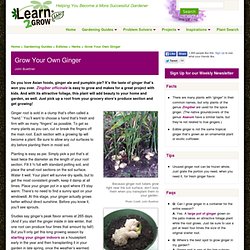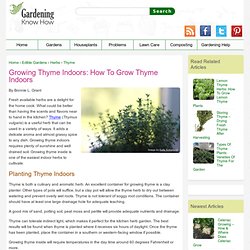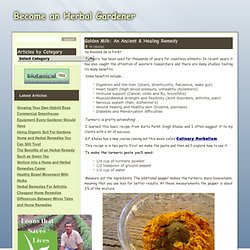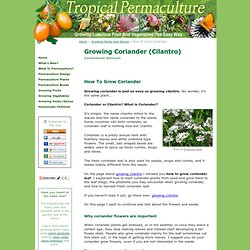

Growing Ginger. Do you love Asian foods, ginger ale and pumpkin pie?

It’s the taste of ginger that’s won you over. Zingiber officinale is easy to grow and makes for a great project with kids. And with its attractive foliage, this plant will add beauty to your home and garden, as well. Just pick up a root from your grocery store’s produce section and get growing! Because ginger root tubers grow right near the soil surface, don’t bury them when you transplant them to your garden. Photo Credit: John Buettner Simply lay the ginger root on the top of the potting soil to “plant” it. Pull the roots from the ground and allow them to dry in the open air before removing the stalks and harvesting. Ginger root is sold in a clump that’s often called a “hand.” Planting is easy as pie: Simply pick a pot that’s at least twice the diameter as the length of your root section. Growing Thyme Indoors. By Bonnie L.

Grant Fresh available herbs are a delight for the home cook. What could be better than having the scents and flavors near to hand in the kitchen? Thyme (Thymus vulgaris) is a useful herb that can be used in a variety of ways. It adds a delicate aroma and almost grassy spice to any dish. Planting Thyme Indoors Thyme is both a culinary and aromatic herb. A good mix of sand, potting soil, peat moss and perlite will provide adequate nutrients and drainage. Thyme can tolerate indirect light, which makes it perfect for the kitchen herb garden. Growing thyme inside will require temperatures in the day time around 60 degrees Fahrenheit or more. How to Grow Thyme Indoors Herb care for plants indoors is much the same as for those outdoors.
Fertilize thyme with a weak solution of fish emulsion or liquid seaweed, diluted by half every two weeks. Cut back overly woody stems on the thyme plant to force fresh new growth. Basil Preservation. A Bounty of Basil: How to Preserve the Harvest by Sandra Bowens One of the most common questions to this site is "can you freeze basil?
" The short answer is yes. The more elaborate answer involves how best to do it. As regular readers know, I love to experiment so I decided to play with the idea. Since it was mid-winter when I became inspired I had to turn to the supermarket for the basil. First, the freezer Most of the books on my shelf suggest blanching basil leaves before freezing. Cubes My favorite way to preserve fresh basil has long been to chop it and then freeze into ice cubes. For a side by side comparison, I measured two teaspoons chopped basil into each of the cube molds. The food processor came out for the next trial. Submerged in oil. Sage. Salvia officinalis Common name for the two genera Salvia and Audibertia; but most popularly for the hardy sub-shrub Salvia officinalis, which is extensively grown for seasoning dressings used with rich meats, and for flavoring sausages and cheese.
Growing the Herb Sage Seeds should be sown thinly indoors or in outdoor cold frames. Transplant when plants are large enough to move, setting them at least 18 inches apart, and providing a clean growing area. As the plants often exceed 3 feet in diameter, they should be planted at least that far apart. Sage grows best in a soil comprised of a rich clay loam with an adequate supply of available nitrogen. Sage is easily propagated through stem cuttings, which are easily rooted in sand and other rooting media and then planted in rows three feet apart. Dry in a well-ventilated room on screens away from direct sunlight and then store in tight jars.
Growing Cultures Outdoors, in containers, and hydroponics. Plant Height Plant Spacing Preferred pH Range. Growing Basil. Tumeric Uses. By Rosalee de la Forêt Turmeric has been used for thousands of years for countless ailments.

In recent years it has also caught the attention of western researchers and there are many studies touting its many benefits. Some benefits include… Digestion and the liver (Ulcers, diverticulitis, flatulence, leaky gut)Heart health (High blood pressure, unhealthy cholesterol)Immune support (Cancer, colds and flu, bronchitis)Musculoskeletal strength and flexibility (Joint disorders, arthritis, pain)Nervous system (Pain, Alzheimer’s)Wound healing and healthy skin (Eczema, psoriasis)Diabetes and Menstruation difficulties. Coriander/Cilantro Tips. How To Grow Coriander Growing coriander is just as easy as growing cilantro.

No wonder, it's the same plant... Coriander or Cilantro? What is Coriander? It's simple: the name cilantro refers to the leaves and the name coriander to the seeds. Coriander is a pretty annual herb with feathery leaves and white umbrella type flowers. The fresh coriander leaf is also used for salads, soups and curries, and it tastes totally different from the seeds.
On the page about growing cilantro I showed you how to grow coriander leaf. If you haven't read it yet, go there now: growing cilantro. On this page I want to continue and talk about the flowers and seeds. Why coriander flowers are important When coriander plants get stressed, or in hot weather, or once they reach a certain age, they stop making leaves and instead start developing a tall flower stalk.